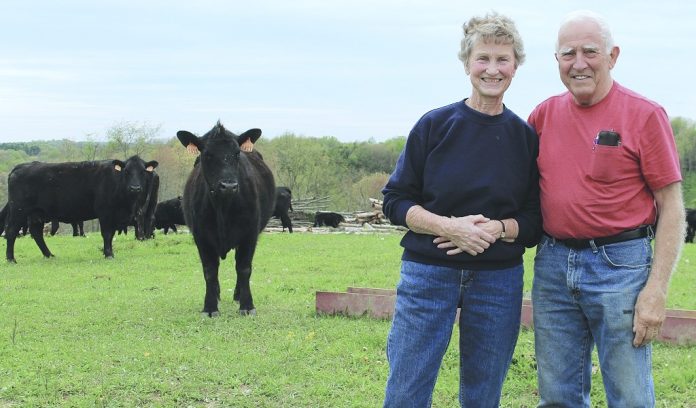
CARROLLTON, Ohio — Solar installations have grown at an average rate of 72 percent per year between 2010 and 2016, according to the U.S. Energy Information Administration.
Tom and Nancy Bauer, of Carrollton, have been part of the solar boost, installing two systems with in the last five years.
The Bauers own and operate a beef operation, including 75 acres of grain and 250 acres of hay. They originally purchased 304 acres for hunting in 1993, and have since grown to around 1,000 acres. Tom owned an air conditioning company in Randolph, Ohio, for many years, and, after selling it, they moved to the country for their “retirement,” he said.
“We discovered how beautiful the area is in 1981 when we bought a cottage on Leesville Lake. Now we live here year-round and tend to our cattle,” Nancy said.
Solar system
The Bauers installed their first solar system in October 2012.
“Honestly, I just decided I wanted to know more about it and saw an ad in the Farm and Dairy,” Tom said.
The advertisement was for Paradise Energy Solutions, which walked the Bauers through the process.
Sheldon Stutzman, solar consultant with Paradise Energy Solutions, has been working on energy systems for five years. Paradise opened its doors in Lancaster, Pennsylvania, in 2009 and opened a Sugarcreek, Ohio, office in 2011. Since 2009, Paradise has installed more than 750 solar systems in eight states.
“Tom had a lot of great questions,” Stutzman said. “It is great when a customer really understands their own system.”
“In the last five years, people’s perspective on solar has changed,” Stutzman said. “It has proven itself. The unknown and misconceptions are being swayed by people who took the chance.”
Educate
Solar panel costs have come down and installation efficiency has increased, resulting in about a 20 percent decrease in cost in the last five years, he said.
“Anybody with an electric bill is a good candidate,” Stutzman said, “especially owners of animal confinement buildings. Their energy needs increase in the summer to keep the buildings cool, which matches the natural increase in solar production.”
The system the Bauers settled on is for 24 kilowatts, which is 75-80 percent of the energy the farm is projected to use annually. They expect to get their return on investment in seven to eight years, Tom said.
They installed 105 panels on a pole barn that was closest to the road. Each panel can be monitored online for performance and maintenance needs, and Tom can see how much energy each panel is producing at any moment.
Paradise Energy guarantees the panels will perform at 85 percent or greater for 25 years, said Tom.
“We haven’t had any issues, other than a coon chewing through a wire. It got to the wire by climbing a tree, so we cut it [the tree] down and haven’t had a problem since,” Tom said.
The solar energy powers the farm and a home on the property, which is rented.
If excess is generated, it is sent to the Carroll Electric Cooperative, Inc. The cooperative records the units of energy the Bauer farm produces and uses, and gives them a monetary credit for unused units. If the overproduction continues, however, for a 12-month period, they are required to connect with the co-op’s wholesale power provider Buckeye Power as a generator of electricity.


Second system
The Bauers have been so pleased with the solar power, they installed a second system of 12.5 kilowatts on another building on the property, powering a few additional buildings.
This is a good time to consider solar energy, Stutzman said, as there is still an income tax break and competitive USDA grant dollars available.
“The USDA grant it is a very competitive grant, but, if awarded, would cover 25 percent of the qualified project cost. We help our clients evaluate if they could be a good candidate for the grant and help establish realistic expectations,” he said.
Since 2005, the federal government has provided a 30 percent investment tax credit, which is scheduled to phase down or expire by 2022.
“If you can pay your electric bill, you likely can afford solar.”
Thinking of installing solar?
Ohio State University Extension resources:
Penn State University Extension resources:Talk to Tom Bauer about his experience: 330-627-3146 or bauerbeef01@aol.com
Herd management
The Bauers raise mostly Angus cattle on grass for two years before finishing them on grain and hay for the last 60-90 days. The herd calves in the spring, anywhere from March 1 to the end of May. This year, they have had 96 calves.
Tom, 75, manages the cattle’s rotational grazing program. They are split into five groups, and he moves the groups from one paddock to another every one to two days. Over the years, they have installed about 17,000 feet of waterlines from natural springs with a force system, allowing him to get water to his cows easily on each paddock.
The Bauers employ one full-time worker, in addition to themselves, to help tend to the 250 head of cattle.
Diversification
Similar to taking a leap with solar energy, the Bauers are also progressive in their rotational grazing system and diversifying with Wagyu calves. Two years ago, he began artificially inseminate some of his cows with Wagyu semen. So far, they have had 39 calves half Angus, half Wagyu. Wagyu are genetically predisposed to have intense marbling and to produce a high percentage of oleaginous unsaturated fat.
They sell beef by the side directly from the farm, and take steers to be processed every other week. They don’t spend any money on marketing, Nancy said, and opinions of their beef spread by word-of-mouth.
They also sell feeder steers to the Mahoning County Steer Club and have raised three out of the last four Mahoning County grand champion steers, which has brought more business their way.











